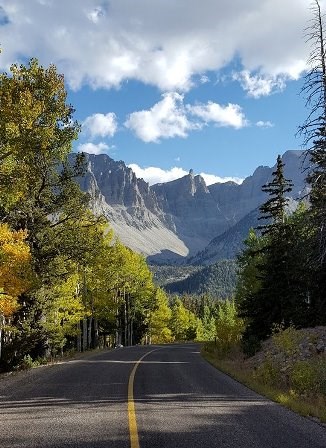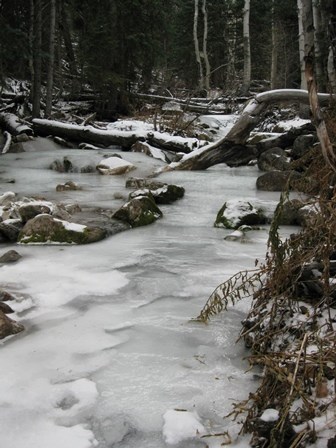Nearest Medical FacilitiesCall 911 for emergency medical or police assistance or to report accidents or injuries. 
NPS Photo/Stephanie Campbell Cell Phone UseCell phone reception is not reliable in the park and surrounding areas. Do not rely on them! In case of emergency, call 911 from a landline or contact a park ranger or campground host. DehydrationIt is easy to become dehydrated when hiking in the dry desert air. Carry plenty of water and drink it! Note: All surface water should be chemically treated, boiled, or passed through a filter capable of eliminating harmful microbes and parasites, such as giardia, before drinking. DrivingDriving conditions in the park can be hazardous. Please obey all posted speed limits, and use lower gears on long downhill sections to prevent overheated brakes. Seatbelts are required in both Nevada and the park. Please stop only at pullouts. Watch for wildlife - especially deer on the Scenic Drive and marmots on the Baker Creek Road - and pedestrians. Congestion in the visitor center parking areas can lead to accidents. 
NPS Photo Altitude SicknessAltitude sickness is a condition brought on by high elevations often in conjunction with strenuous activity. Symptoms include difficulty breathing, nausea, incoherent speech, and headache. The cure is to descend immediately. Altitude sickness can be life threatening. To avoid altitude sickness, ascend slowly, eat lightly and frequently, and drink plenty of water. LightningLightning injures more people every year than wildlife. Be on the lookout for fast moving dark clouds and the sound of thunder. Electrical storms are common in the summer months, with frequent quick changes in the weather. Move away from exposed ridges and summits, and immediately descend to lower elevations if threatening clouds begin to build. During storms, winds at ridgelines above 10,000 feet are often 30-60 miles per hour. Do not take cover under trees when lightning is imminent. In open areas, crouch low to the ground. Avoid being the tallest object and don’t be around other tall objects (i.e. lone trees) when lightning is imminent. Sun ExposureSunburn is a common problem when hiking at high elevations. The atmosphere is thin and does not filter the sun's rays, so people burn quickly. Wear a hat and sunscreen. Excessive sun exposure, combined with high temperatures, can cause heat stroke. Talus SlopesTalus slopes are common in the park above tree-line. Use caution when hiking in areas such as the Wheeler Peak, Bristlecone Pine, and Glacier Cirque trails. Wear proper footgear that provides ankle support and protects against sharp rocks. Don't be deceived by rocks that appear stable.

NPS Photo HypothermiaHypothermia is a serious condition where a person's body temperature becomes dangerously low. It can occur at temperatures well above freezing. Avoid hypothermia by wearing appropriate, layered clothing. Do not wear cotton clothing, which becomes very cold when wet. Carry extra clothes, drink plenty of fluids, and stay dry. Signs of hypothermia include: uncontrolled shivering and slurred speech, followed by drowsiness, lack of interest, and incoherent speech. If someone shows signs of hypothermia, warm the individual slowly, replace wet clothes with dry ones, and give the person warm liquids without caffeine or alcohol. Avalanche DangerHikers should recognize and avoid areas threatened by avalanches. Ridgelines are generally much safer to travel on than open faces or valleys. Areas with large, healthy trees are less likely to avalanche than barren slopes. 
NPS Photo Backcountry Hiking, Camping, and SkiiingPlanning to spend one or more nights in the backcountry? Please register at a visitor center as a safety precaution. In all cases, you should tell a friend or family member where you are going and when you plan to return. Abandoned MinesAbandoned mines are common in the park and the surrounding region. They can be extremely dangerous. Shafts and tunnels are unstable - do not enter them. Great Basin National Park is currently working to make abandoned mines in this area safer. CampfiresIn established campgrounds, campfires are permitted in fire rings and barbecue grills only. In the backcountry, fires are allowed below 10,000 feet in elevation and groups may not construct their own fire rings. No open fires are allowed anywhere in the park above 10,000 feet. Campfires must be attended at all times, and must be completely out before leaving the area. Exercise caution when using gas stoves, charcoal grills, and cigarettes. Dead and down wood can be gathered and used for firewood, with the exception of Bristlecone pine wood or any type of wood found above 10,000 feet. Chain saws are not permitted anywhere in the park. 
NPS Photo WildlifeWildlife are not tame! Do not feed any animals - including chipmunks or squirrels. Observe wildlife at a safe distance and never approach them. Rattlesnakes are rather timid, and stay camouflaged in sagebrush and rocky ledges. The greatest potential risk occurs when gathering wood, reaching into brush, or on rocky ledges. Stepping on a snake is a potential hazard, and is one reason you should stay on maintained trails, where snakes are easiest to see. |
Last updated: June 27, 2025
